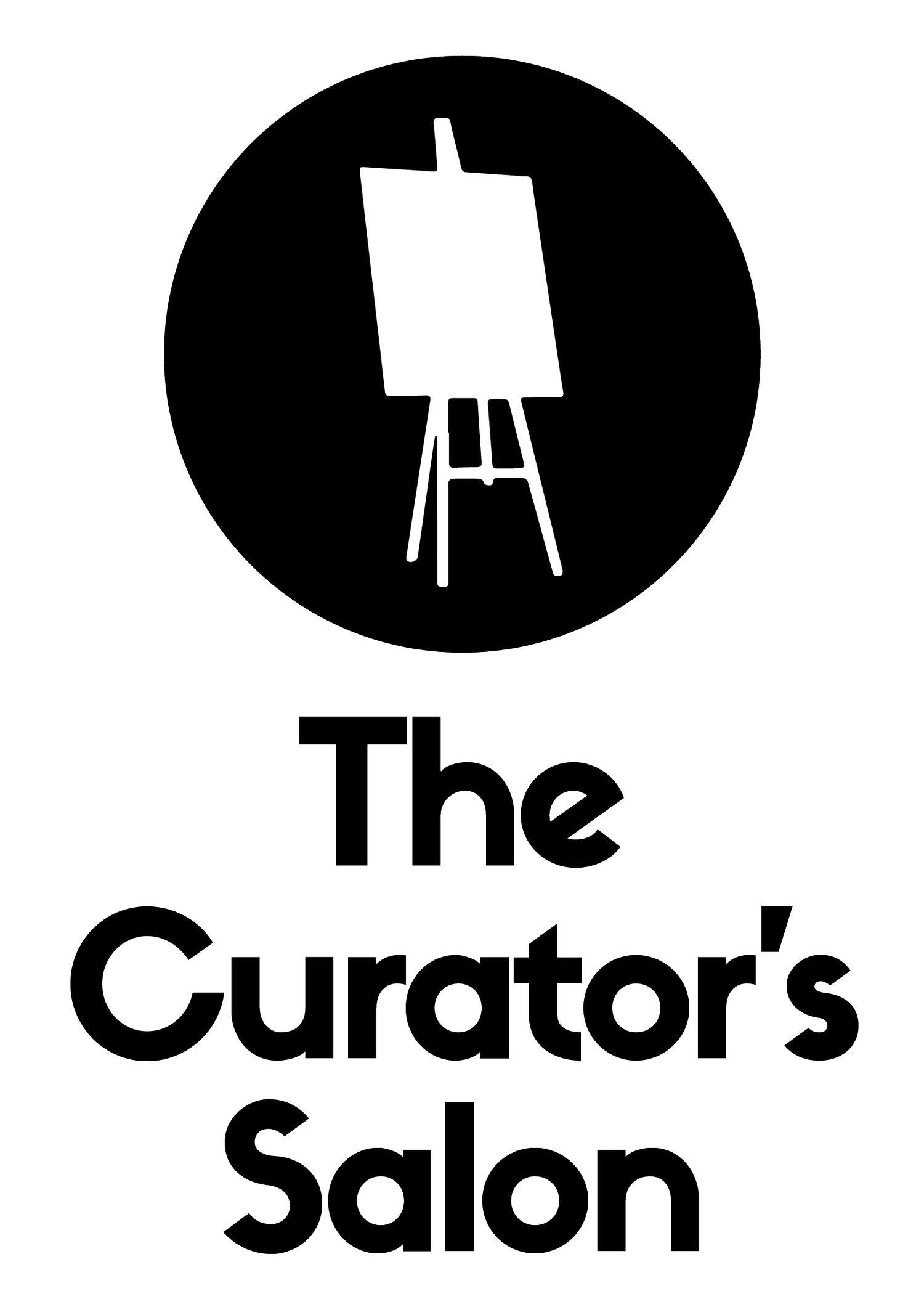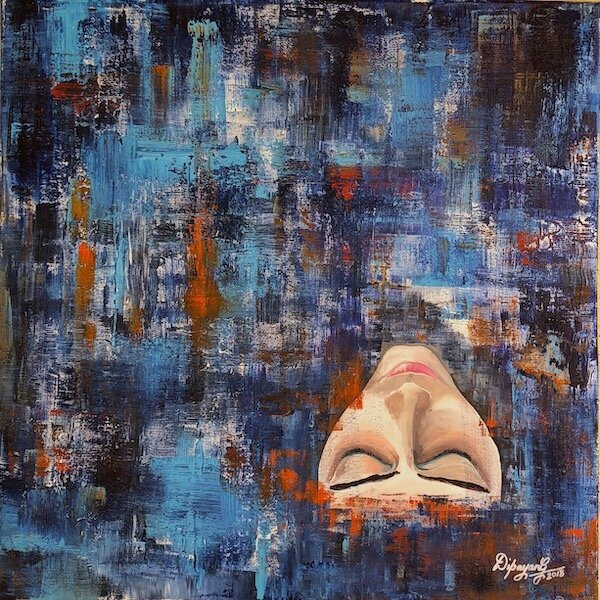Dipayan Ghosh
I had the chance to interview Dipayan Ghosh, Kolkata-born artist who shares his interest in the traditions of India and its people through his beautiful expressionist and cubist works.
Aanandamai (Sheath of Blissfulness Gaine de Béatitude) by Dipayan Ghosh
Can you share about your background and the evolution of your practice?
Born in Kolkata (Calcutta), a city whose very soul is soaked in the spirit of art for centuries and having witnessed some unique confluences of western methods of the British East India Company and Indian Mughal themes, I started my journey of art at quite a tender age in the 80s.
In my early years, I became deeply intrigued by the quintessential art of the European Renaissance era as well as the avant garde Bengal School of Art that was started by Abanindranath Tagore and the British art teacher E. B. Havell in early 20thcentury. The vibrant and generous use of dramatism in the art of those movements had left me spellbound. The play of lights and the use of colours soared those artworks in “value” and “tone”. I tutored under a teacher affiliated with the Academy of Fine Arts in Kolkata who further introduced me to the techniques of the likes of William Turner, Cezanne, Van Gogh, Jatin Das and Picasso. In his tutorship and supported by ample encouragement from my kith and kin, especially by mother, I went on to dabble and disport with various mediums of oil pastels, charcoal sticks, watercolours and the traditional oil and gouache.
Nevertheless, my artery was seldom smooth and not by much undeviating. Very typically, I was lured away into the lustrous streams of mathematics, engineering and business school. And, quite invariably, as I was lazing in the sunshine of my 25thsummer, I found myself among perplexing paraphernalia of technology endowed with phlegmatic business plans. A keen eye of art remained in the dregs of the soul yearning to lust on its taste again. A decade later, re-flattered by my fiery fans, I returned to art. The mediums had undergone a sea-change and the wonder medium of acrylic had emerged that can emulate, with varied application, both the oil and the watercolor yet dries instantly. I found my solace in the arms of acrylic and rekindled my old love for Indo-European Expressionism.
Starting with the India Art Festivals of Mumbai and Delhi, my art found curator appreciation to the Galerie Metanoia in Paris, Elizabeth James Gallery and Happenstance in London.
Annamai (Sheath of Nourishment Gaine de Nourriture) by Dipayan Ghosh
I am a member of Fine Art Trade Guild, London; ISAP and NOAPS, USA; 4Art Tech in Switzerland and TRiCERA, Japan. My art has been showcased in Paris, London, Venice, India, USA and featured in Fine Art Connoisseur magazine.
What ideas are you exploring in your work?
My works are based on the experimental application of European Renaissance style of Cubism and Expressionism to Oriental Indian themes; and overlaid on bas relief sculptural surfaces.
Indian art forms, although rich in her culture and traditions, have always been based on hyper-realism or impressionism. But my principal goal has been to use the deconstructed style of cubism or geometric abstraction to depict the vibrancy of Indian themes. I also experiment with colours and semi-3D textural techniques to depict the mood of my themes.
What is your artistic process?
While making my artwork, I believe in ‘roughing’ up my stretched canvas after priming it with gesso. I use textures like modelling pastes, white opaque flakes, resin sand, ceramic stucco or black lava to create the base notes. These base notes would be semi 3D bas relief on the canvas. Then use several layers of ‘hatching strokes’ with a broad brush of bold colors to lay the medium notes adopting a cubist-expressionism style; before topping the canvas with the prime actor of the story using a semi-realistic method.
In my experimental technique, the colour palette represent the mood. I like to use the inherent meanings of the colours, viz Red for energy, desire; Pink for love and romance; Yellow for happiness, newness; Blue for peace, calm, etc. My experimentation with textures also signify the coarseness or smoothness of the theme that I am portraying. The use of modelling pastes and ceramic textures help me define objects in my 2D art with 3D effects of bas relief. And lastly, I like to use the cubist and geometric abstraction techniques to deconstruct the Indian themes and create a fresh new perspective of oriental Indian art.
Samprikt by Dipayan Ghosh
My artworks are mostly a series of 3 to 10 paintings that describe a string of thoughts but at the same time stand on their own. This also helps me portray philosophical themes in modern techniques. For example, one of my projects have been a series of 5 paintings based on “Panchakosh” (5 Sheaths that cover our soul). Annamai (Sheath of Nourishment), Praanamai (Sheath of Vitality), Manomai (Sheath of Emotions), Viggyaanamai (Sheath of Intellect) and Aanandamai (Sheath of Blissfulness), which are the five sheaths that the soul is covered with. These layers, very similar to “the Onion Metaphor”, gradually unveil the truth of the soul. The first is about the physical body, then comes the life, then the emotions, and knowledge and the last one the enlightenment through knowledge and is nearest to the soul. Here, I had deconstructed perspective with a tinge of cubist methods and overlaid it with wild impasto and textures; and associated each of the kosh (sheath) with a mythological symbolism, Ganpati for Annamai, Nataraj for Praan or Vitality, Draupadi for Manomai, Saraswati for Viggyaanamai and Buddha for Blissfulness. Also lightened up the colours as we reach nearer to the soul.
My finished works would most-certainly be full of bravado and boldness to light up a positive impact on the soul.
Can you share some favourite quotes?
I am deeply inspired by Picasso and Van Gogh; and the quotes that I love are:
“If I paint a wild horse, you might not see the horse ... but surely you will see the wildness!” — Pablo Picasso
“Painting is a blind man’s profession. He paints not what he sees, but what he feels, what he tells himself about what he has seen”
— Pablo Picasso
“If I am worth anything later, I am worth something now. For wheat is wheat, even if people think it is a grass in the beginning.”
― Vincent van Gogh
Sooti by Dipayan Ghosh
Which 3 artists do you enjoy at the moment?
Bethany Holmes, @bethanyholmesart
Jessica Enneby Eldenstjarna, @jessicaeldenstjarna_art
Gale Wareham, @GailWarehamArtwork
What is the most memorable thing someone has said about your work?
I love the pose Dipayan! You captured vitality, agility and life beautifully! And the multi layering of energies are powerful! – Jessica Eldenstjarna (Artist)
Dipayan Ghosh’s works give us a glimpse of the body in the process of an inner transformation. His vibrant paintings veer towards abstract impressionism – he fragments the forms into overlapping geometrical shapes that subvert the traditional depiction that relies on the imitation of forms. Female mystics and figures of gods seem to be caught at the centre of a shapeshifting labyrinth, denoting the ephemerality and illusion of life. There is an insinuation of the final form, like pieces of a complex riddle. The effect produced is of bodies and faces refracted through a series of mirrors. – Art India Magazine
What are you working on now?
I am working on two projects “Dasagriva” and “Gunatray” now.
“Dasagriva”, as a series, would portray the 10 heads of Ravana that symbolizes the 6 shastras and 4 vedas, making him a great scholar and of supreme intelligence.
The 10 heads represent the 10 basic emotions of human beings as Kama (lust), Krodha (anger), Moha (delusion), Lobha (greed), Mada (pride), Maatsyasya (envy), Manas (mind), Buddhi (intellect), Chitta (will) and Ahamkara (the ego). The series would consist of 10 artworks that would use symbolizations and abstractions to express these 10 emotions that make a complete human being.
“Gunatray”, as a series, would portray the three gunas: Sattva (purity), Rajas (activity) and Tamas (darkness, destruction). Gunas are present in everything; humans, food, animate and innate objects. The series would have 3 artworks using distinct colour shades and symbolism to represent each guna. “Sattva”, with symbolization of the moon would delve on greenish, bluish and whitish tinges. “Rajas”, with symbolization of Venus and Mercury would rely on gold, yellow and orange to represent pleasure, prosperity and desire. “Tamas” on the other hand would base itself on darker shades with Mars as the symbolization.
Give Dipayan a follow on Instagram @dipayang.




